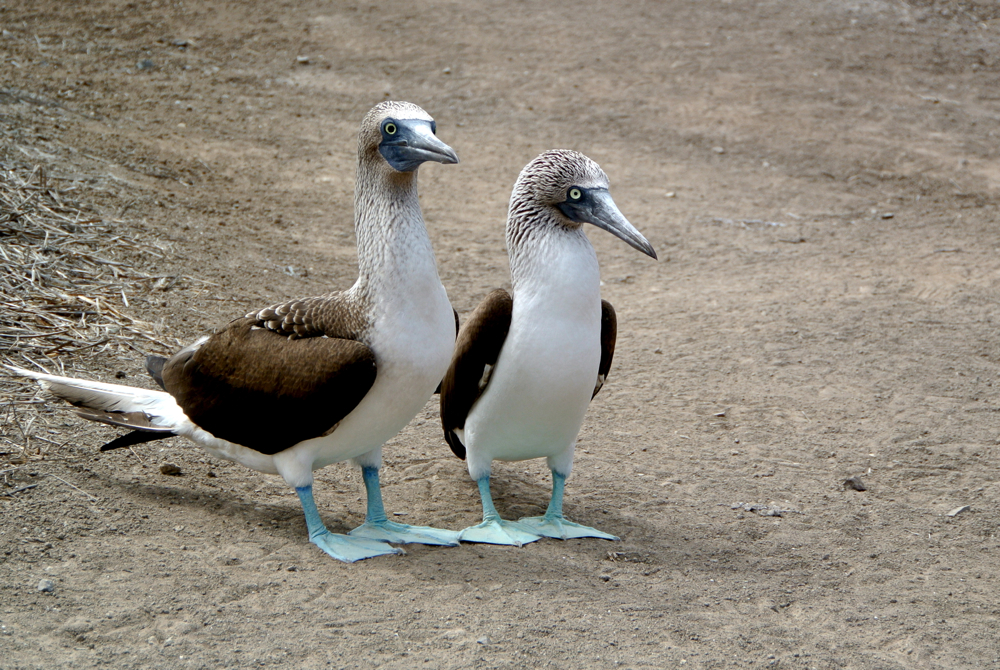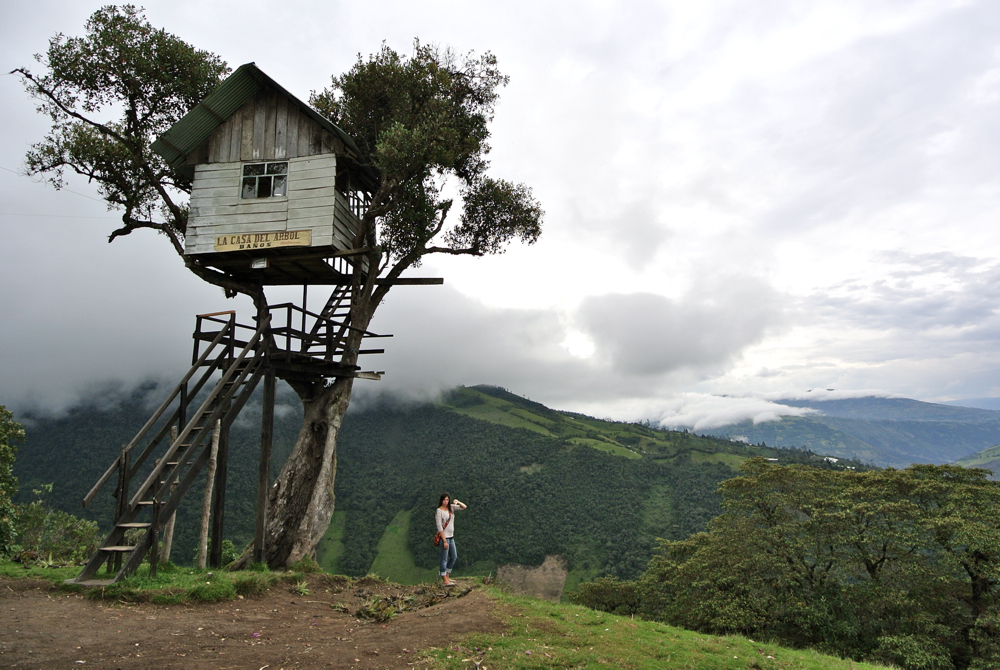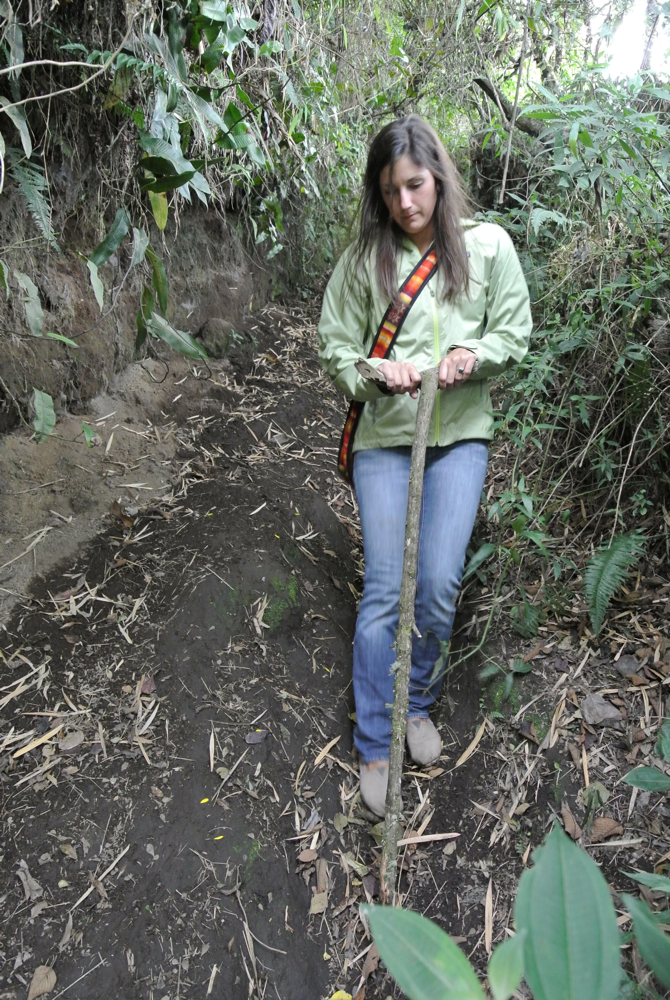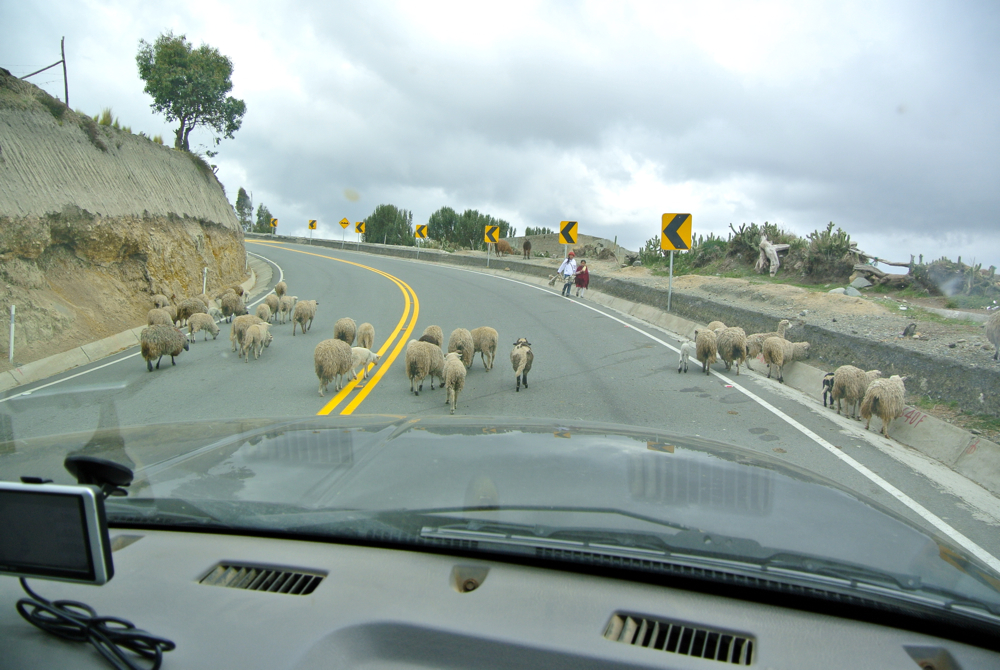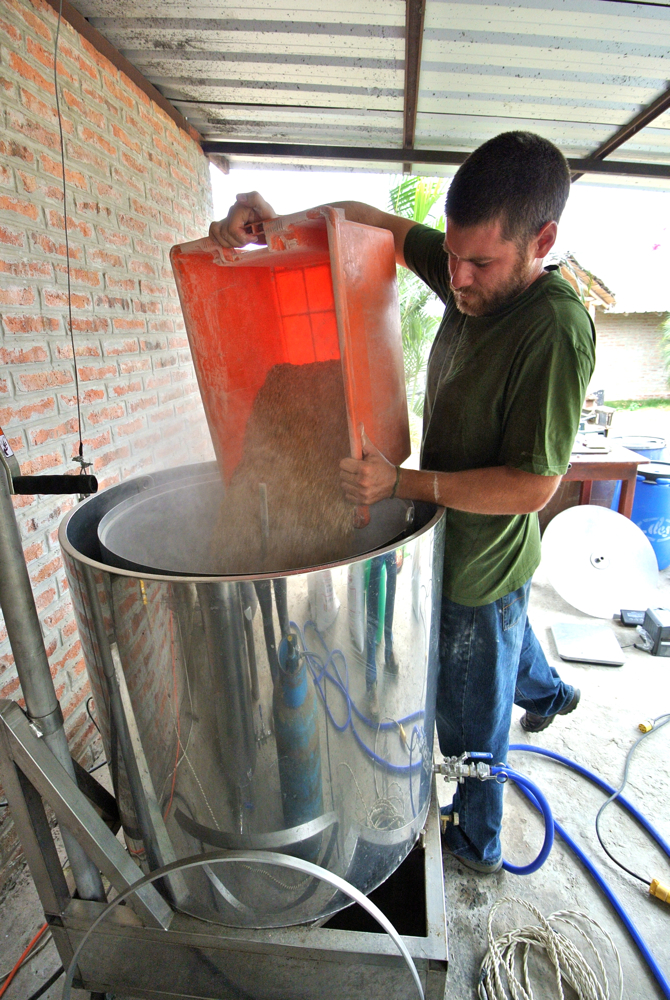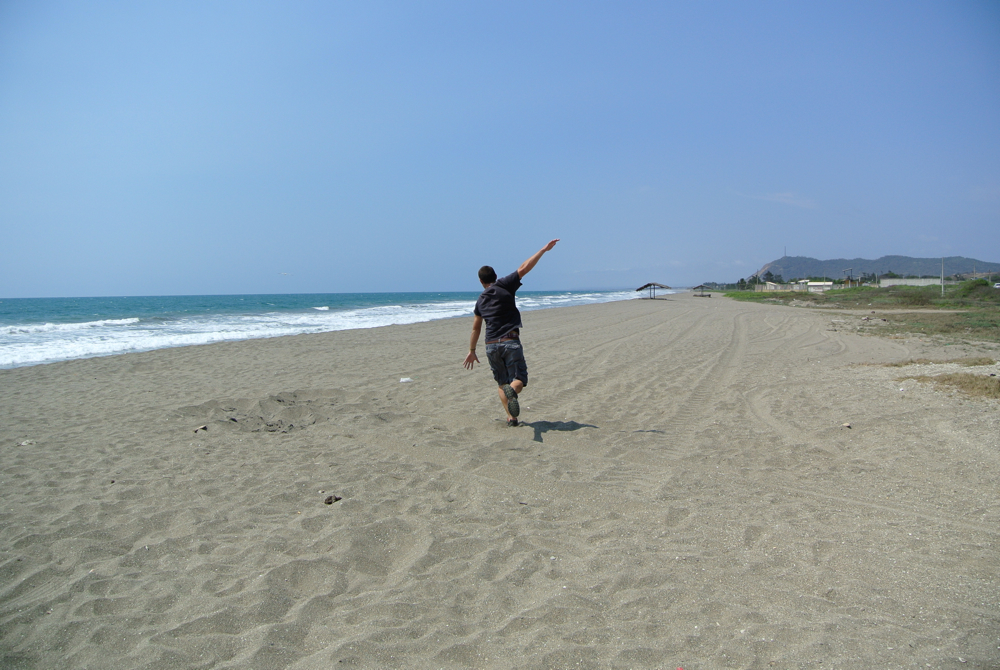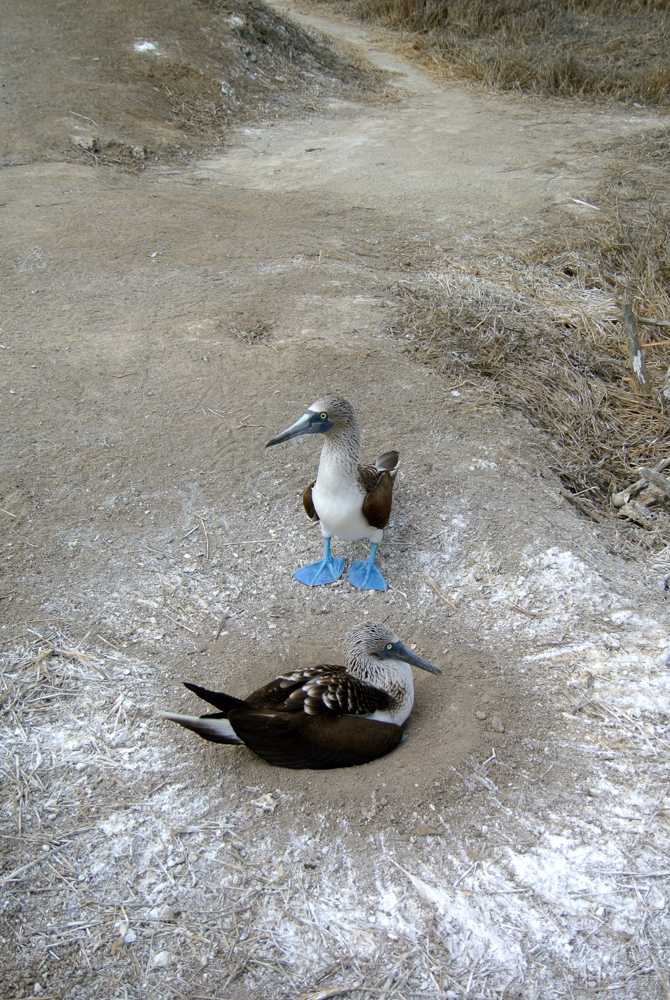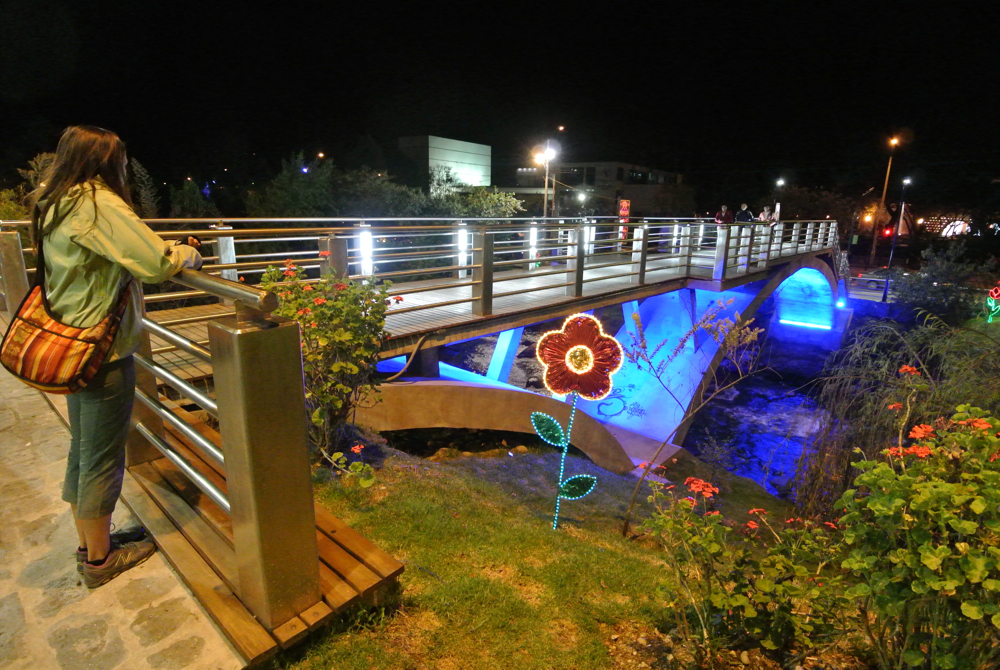D
Deleted member 12023
Guest
GRAND MARKETS AND MOUNTAINS
December 4, 2013 · by Sarah
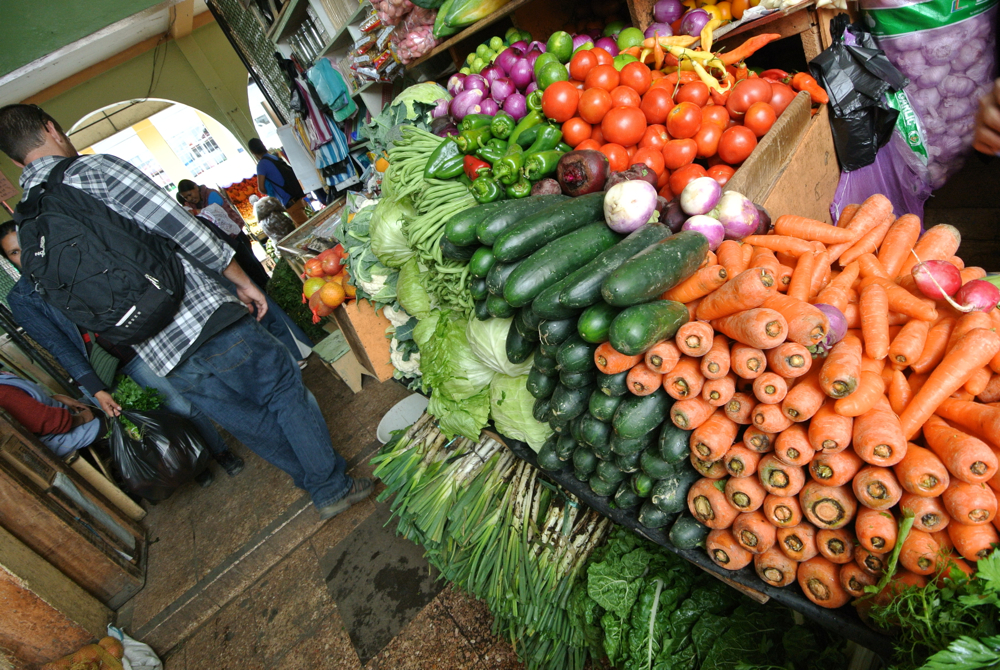
Papers in hand, we were ready for our tenth border crossing. In a matter of fifteen minutes, all three of us were officially “checked out” of Colombia and on our way to Ecuador. Just as easily as we left Colombia, we entered Ecuador except for one minor hitch. After getting our passports stamped, we went to aduana (customs) where we were to obtain a vehicle import permit for the truck. Approaching the doorway, the man informed us of all the documents needed for the permit. We had everything we needed except for insurance for the vehicle. We had heard mixed reviews on whether you legally needed insurance in Ecuador, but with the official telling us it was necessary and it being printed on ‘the list’ hung all around the office, we were sent on a hunt to find it.
We were directed across the street where we could find a little tienda (shop) that would sell us insurance. We carefully crossed the street, while the police officer blew his whistle for us to hurry up, and approached the tienda. To our dismay, it was closed. We went to the shop next door and asked if she sold insurance. With a big head shake from side to side, she let us know that the shop next to her was closed (duh) and that we would have to go to Tulcan to buy it. Not wanting to drive the truck without insurance because of our previous misfortune in Colombia, we opted to grab a taxi.
After a twenty minute ride, we walked into the SOAT office. We explained what had just happened to the nice woman who shook her head and told us that she could not sell us insurance because we have a foreign vehicle and that we would have to go to Ibarra. Ibarra is the next biggest town…about three hours away. At this point we didn’t know what to do, so we just hopped into the taxi and went back to the border. Since we were officially checked into Ecuador and our truck was not, we didn’t have many choices.
To our surprise, the tienda was open when we got back! Excited, we skipped across the street and eagerly handed over our papers. For the next hour, we waited while the woman, wrapped in a fleece blanket, typed information into the computer. She would get distracted adding minutes to people’s phones for them, selling a trinket, or making change for people’s pesos, but would always go back to filling out our insurance form. At one point, she looked up, shaking her head back and forth, and said, “No, no hay.” There is none? What does that mean?? I could see the look across Nate’s face. It was similar to the look a child gives you after you give it candy and then take it away. Confused, frustrated, pissed. She told us she had the actual card, but she did not have any left in her computer. Stumped, we did the walk of shame back to the aduana official and told him what we had just done for the past two hours. Feeling sorry for us, he issued us an import permit anyway and told us to buy insurance right away in Ibarra.

Feeling lucky, but also nervous because we lacked insurance, we drove out of the border area on the nicely paved road. We were greeted by a gas station displaying a sign that read “Diesel $1.02” per gallon!!!! Although excited, we knew we couldn’t fill up Truck as the government has strict regulations banning the sale of more than ten gallons at a time within fifty miles of the border.
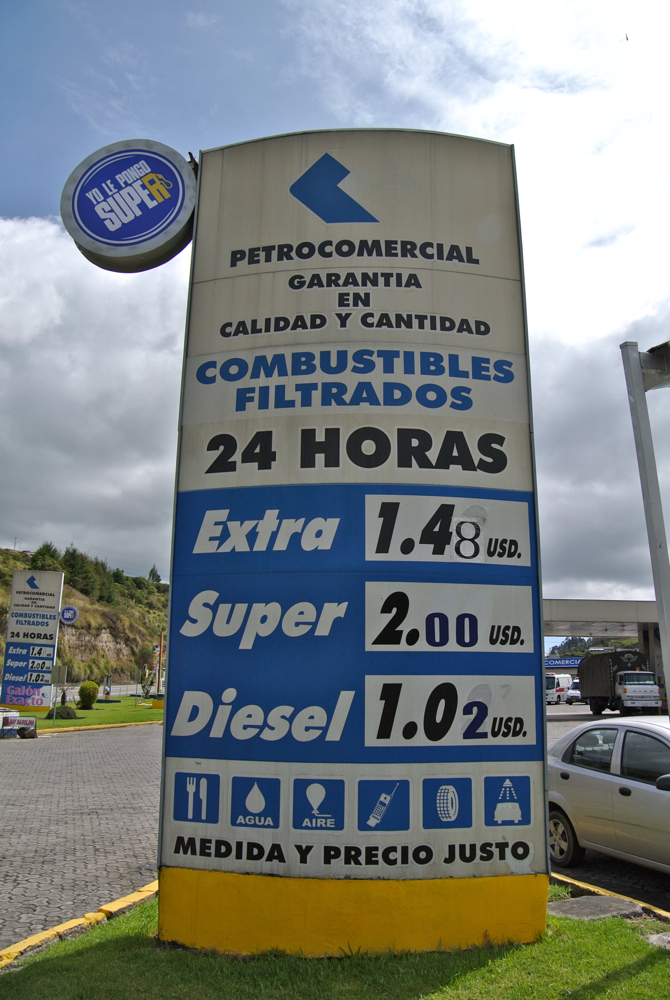
Ecuador has beautifully maintained roads and many are under construction as well. We were whizzing along the highway, eager to get to our first stop when we were forced to come to a halt. We had hit a section of road that was closed off due to repairs so we threw the truck in park and got comfortable. While waiting, a little old man was walking from car to car selling homemade popsicles out of his homemade cooler. We grabbed two and ate them while listening to music to pass the time.
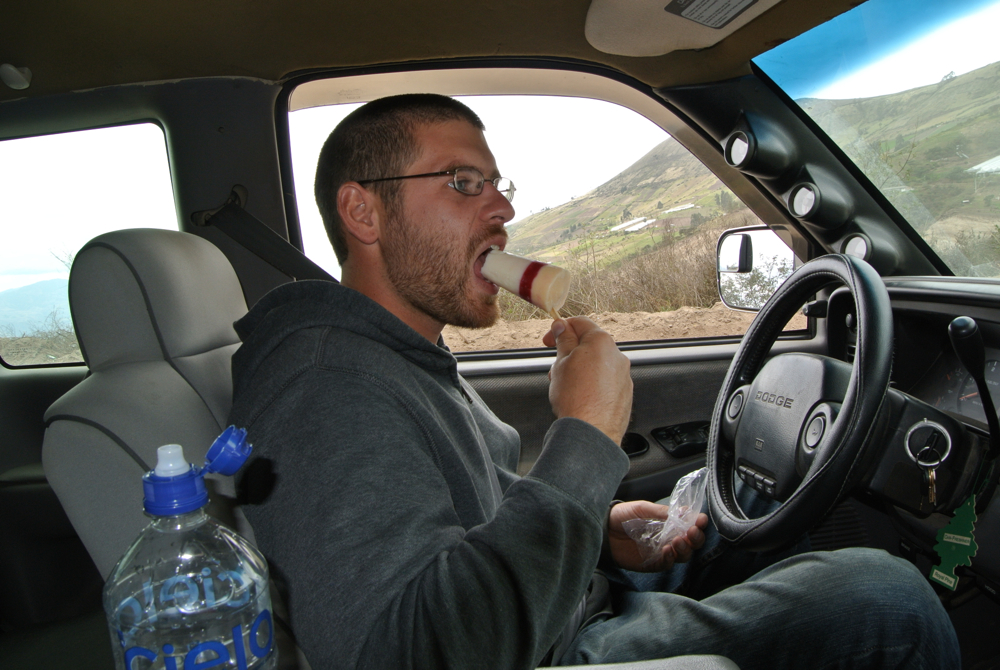
We arrived in Otavalo mid-afternoon at our camp spot that overlooked the town and gave glorious views of the mountains surrounding us. We were still in awe at the different landscapes South America has to offer. That night, we made dinner to the view of the lit up town at the base of Volcan Cotocachi. The way the lights all came together gave the image that the volcano was on fire.

The next morning, we set off on foot to discover the town and find a shop to make us a new brake line. We only had one more that was showing signs of rot and wanted to take care of it before we had another incident like we did in Costa Rica or by the lake in Colombia. Thinking we were being smart by repairing it before it rotted all the way through, we found a shop, had one made and went back to the truck to take care of business. After about a half hour of Nate frigging with the brake line, he just couldn’t get the fittings to thread correctly. The man at the shop had given us metric fittings instead of standard. Although it was only the slightest bit of difference, it wouldn’t work. We went back to the shop, old standard fittings in hand, and asked the guy if he had any SAE fittings. He assured us the metric ones would work but we told him it didn’t. After a scavenger hunt to five other hardware stores, we couldn’t find the right fittings so decided to have him use the old ones.
In the middle of our galavanting around town for the new brake line, Nate and I decided to grab lunch at a cafeteria. Almuerzo (lunch) is considered the main meal of the day for Ecuadorians. Typically, it starts out with a piping hot bowl of soup followed by a heaping plate of rice, salad and chicken, beef or fish. We sat down and were immediately served a giant bowl of chicken soup. After we scarfed that, we were served beef with a mushroom cream sauce, rice and salad with a cup of juice. Each meal cost us only two dollars! Bellies full and huge grins strung across our faces, we waddled out of the restaurant to continue our walk back to camp.
Once back at the truck, Nate put the new line on. He was able to thread the fittings but the line wouldn’t stop leaking. We came to the conclusion that the flare wasn’t butting up to the housing correctly. We went back to the shop and asked the man to make a new flare for us because the other flare was crooked. After closely inspecting it, we were happy with the new flare job and went back to the truck. Nate, already covered in brake fluid, climbed back under the truck and attached the line again. After hours of tightening, loosening and re-tightening, it still wouldn’t stop leaking. I could see he was starting to regret our choice of taking it apart in the first place. Technically, nothing was wrong with the other one and now we had one that wouldn’t stop leaking. This time, I told Nate I would grab a taxi and make my way to town to get the flare fixed.

Taxi man at my side, we walked into the hardware store. Just as I was about to explain what I needed him to do, the taxi man grabbed the brake line out of my hand and took over. Once finished, the man handed the brake line back over to me. I inspected it as best I could but seeing as how I know nothing about mechanics and definitely don’t know how a flare should look, I asked him if it would be possible to rent his tool from him. This way, if the flare was wrong, Nate could fix it himself. The guy chuckled and said, “If you want to give me fifty dollars as a deposit then yes! heh heh heh” He was astonished when I slapped fifty bucks down on the counter, grabbed the tool and shoved it in my purse. I knew it was ballsy but didn’t want any more problems and knew Nate could fix it if he had the tool himself. The next morning, Nate borrowed Scott’s Dremel tool and, along with the flaring tool, got the brake to stop leaking. We have now decided not to touch anything unless it is already broken.
Otavalo is famous for its Saturday market, where indigenous people set up shop to sell everything from handicrafts to alpaca blankets to live animals. Of course, being the biggest market in Ecuador, we couldn’t miss out. We got dropped off at the animal market and made our way from there. The first animals we saw were live cows, chickens and pigs. Actually, we could hear the pigs squealing before we even saw them. We made our way over to where there were cats, puppies and guinea pigs being sold. People are very particular about which cuy (guinea pig) they are going to eat for dinner that night. Being a delicacy and all, I guess I would too.

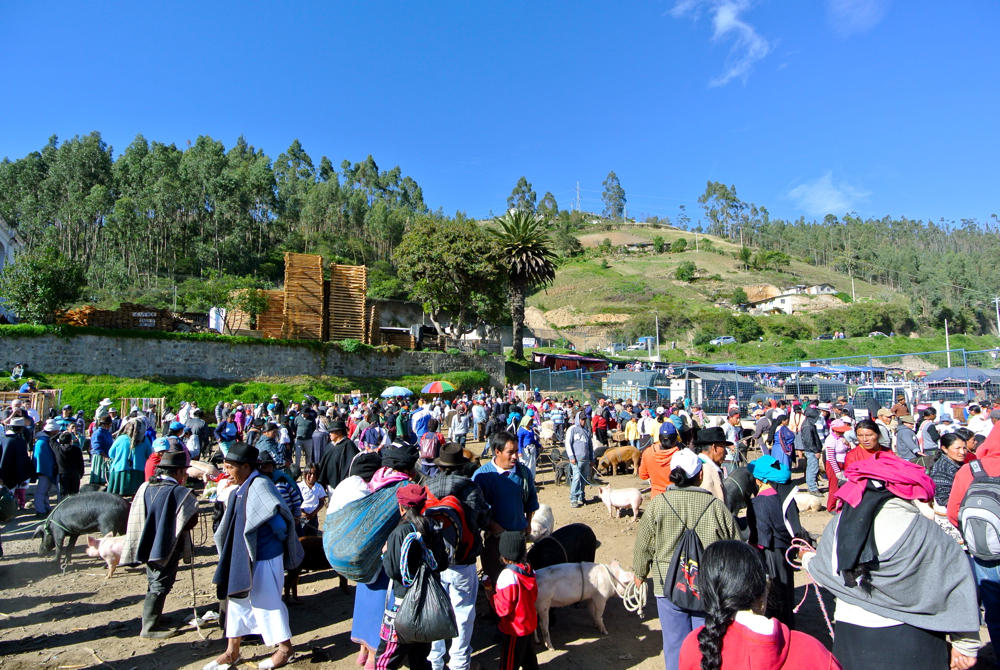
We still have yet to eat guinea pig. I thought it would be a great opportunity to order one up in the cafeteria part of the market. We approached the first stand we saw and the woman informed us that they did in fact serve cuy. She asked me if I would like to see it first to make sure it was an okay size for our meal. I said sure and followed her over to the counter. She reached below the counter, picked up a bag and slapped it on the table. Inside the bag was a LIVE guinea pig. Squeaking and squirming around inside the bag, I felt bad for the little guy. As soon as I saw him, I knew I couldn’t do it. She told me it would take about an hour for it to be ready and asked me if that one was okay. As politely as I could, I told her that we might be back later for lunch. I think she knew we weren’t coming back.
When I was a kid, my sister and I had a guinea pig named Beethoven. I was always a little weird about playing with him outside of his cage, as he kind of freaked me out a bit. However, my sister, being the animal and rodent lover that she is, would play with him all the time. I kid you not about the rodent thing. A few years ago she fostered something like 12 rats at one time in her apartment… RATS! And she loved them too! Until his unfortunate death (even though she is an animal lover, being a kid is tough business and she may or may not have forgotten to feed the thing for, well, long enough that it died) he was a good pet and I am still having a hard time separating the fact that I had one as a pet and the fact that it is considered a part of the Ecuadorian diet.
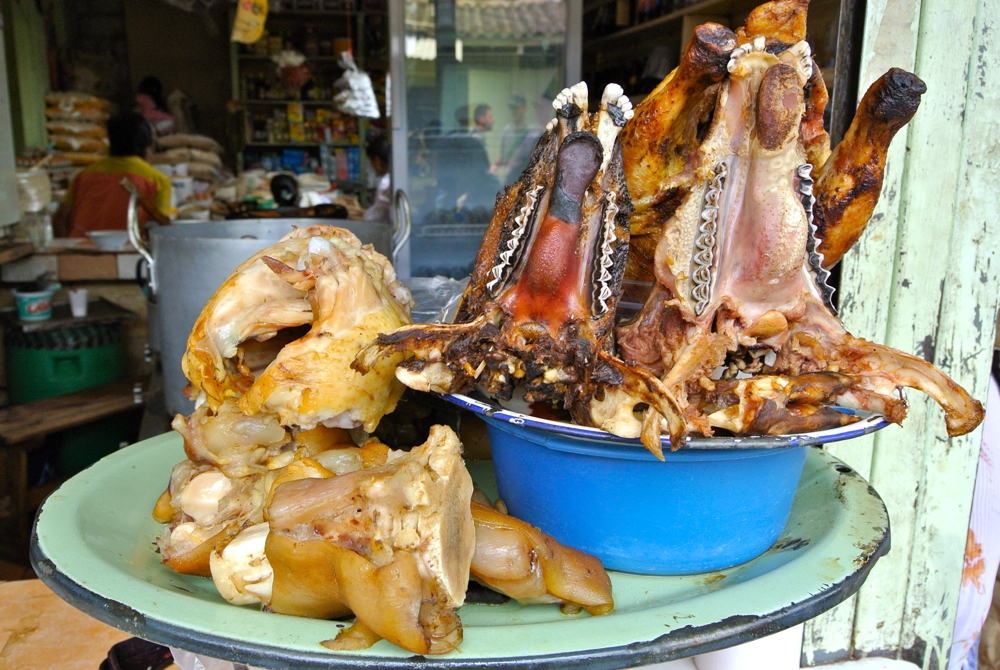
After the animal market, we forced our way through the crowds to the town center where the rest of the market began. The market is so big that it pours into the adjoining streets and the whole town is shut down to traffic on Saturday mornings.

The dress of the locals in Otavalo is very unique. The women wear handmade, embroidered blouses along with either a folded head cloth on top of their head or an embroidered band of fabric wrapped around their ponytail. Their dress reminded us very much of the dress in Guatemala. The men have long hair braided down the center of their back, rope sandals and calf length pants. Some would be wearing a cowboy hat with the ponytail sticking out the back. Nate said they look like badasses and he would totally rock a ponytail with a cowboy hat if his hair would cooperate.
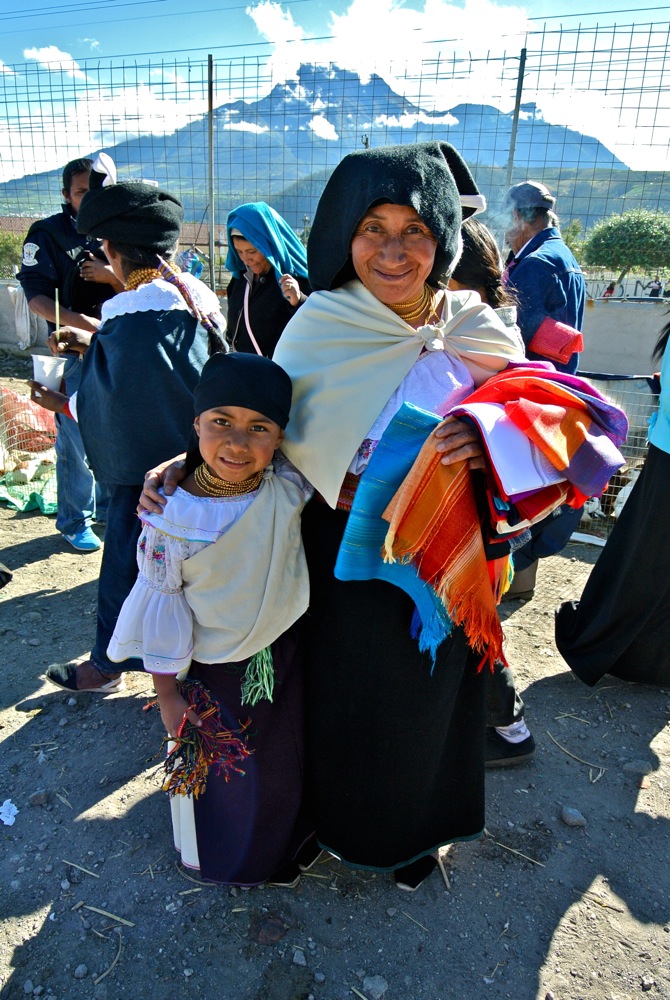
With the internet at your fingertips, it is easy to learn lots of new things. We made the mistake of teaching ourselves how to make pizza in our cast iron pan. We spent seven nights in Otavalo… three of them eating pizza :-/

The worst part? With the leftover dough, we started making cinnamon rolls for breakfast. Fat kids!!!!
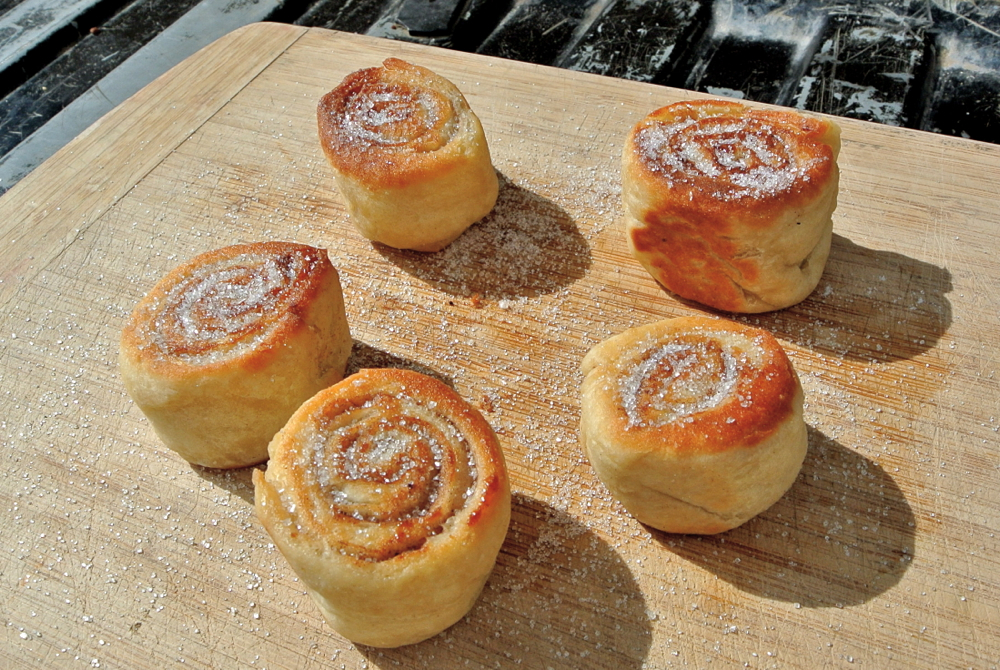
One good thing Nate taught himself (or, I forced him to learn) was how to give me a proper haircut. Layers and all! He got really into a one point, flicking his wrist, saying, “I cannot work under these conditionssss!” with a diva-like attitude, lisp and all.

After about a week in Otavalo, we decided to pack up and head South to Cotopaxi National Park. About an hour into our drive, we stopped at the towering yellow post where the equator lies. We had officially made it to the middle of the world!!
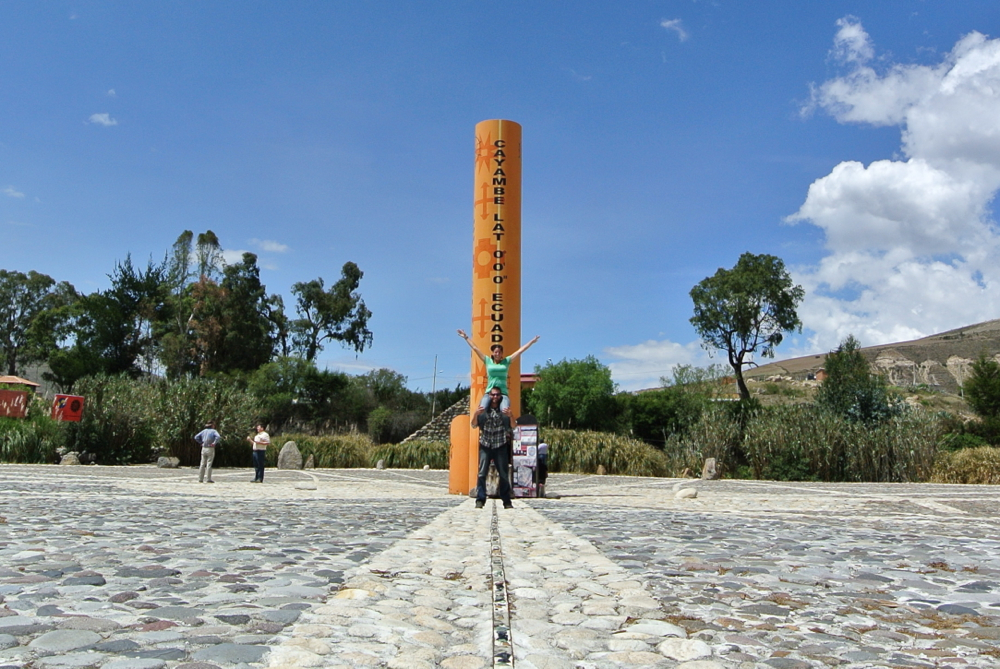
The guide decided it was more important to fully check out our truck instead of giving us the typical tourist speech about the equator. We heard that they give you lots of interesting information about the equator’s history and even do some experiments, but our guide could only be found with his head under the hood of our truck.

Sitting at a whopping 19,347 feet, Volcan Cotopaxi is the tallest active volcano in the world. The park is home to many different landscapes as well. The beginning of the road is dotted with pine trees, planted there in a rehabilitation attempt to equalize the ecosystem. A few miles into the park, the landscape becomes a barren desert with one small, shallow lake on the western side.
We were lucky to get a few glorious glimpses of the volcano on our way to camp that night. The volcano beams high above, topped with an abundance of snow. The chilling view made us stop dead in our tracks, with our jaws hung wide open. This volcano is hardcore, raw and downright ************.

Pulling further into the park, we were engulfed in a think fog. We squinted our eyes to get a better glimpse of the road ahead. We followed the path until we got to our camp spot at the Tambopaxi Lodge. We quickly made our way to the lodge where we got a coffee and a tea and warmed up next to the fireplace.

The next morning, we made a delicious breakfast and sipped our coffee with a beautiful backdrop of the volcano. We are still amazed when we look out the window each morning and have something new to look at. Since we pulled into camp in such a heavy fog, we didn’t know what our surroundings looked like. I rubbed my eyes and pulled the curtain to the side. Like a kid on Christmas morning, I repetitively tapped Nate saying his name over and over until he woke up. Once he did, I said “Look! Look! You can see the volcano!!” And that you could. It was right there, filling up my window like a beautifully brushed painting.

After breakfast, we hit the road and drove up to the parking area where we could grab a trail and hike up to the snow line. Huffing and puffing, we were reminded of our hike in El Cocuy, Colombia where the lung collapsing altitude kicked our butts. This time, we started off about 15,000 and made it to 16,000 before it started snowing/sleeting. Officially the highest either of us have ever been in our lives, I celebrated by building a mini, dirty snowman.
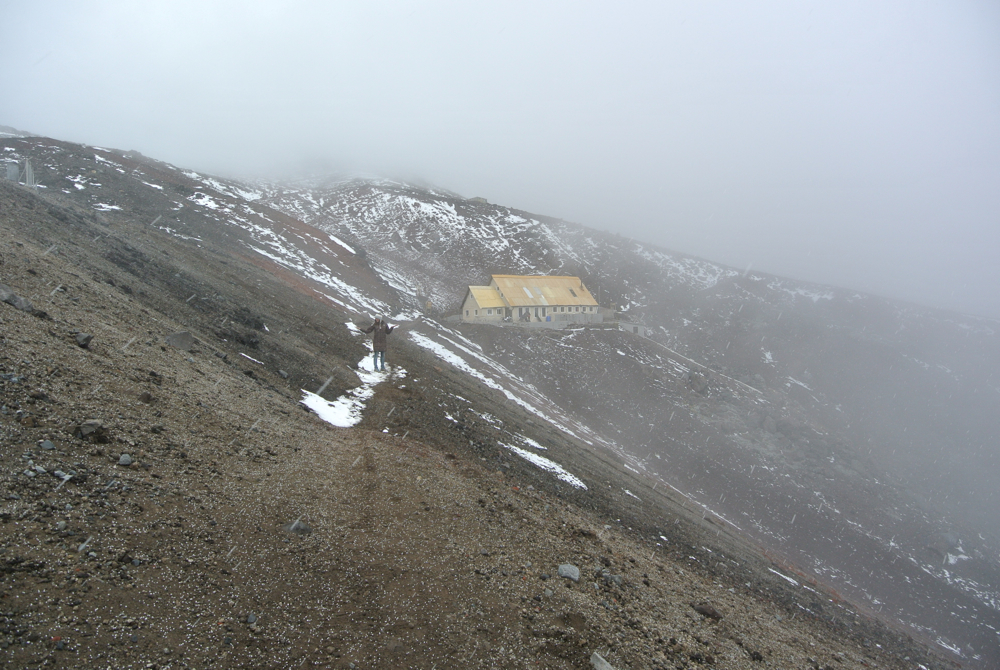


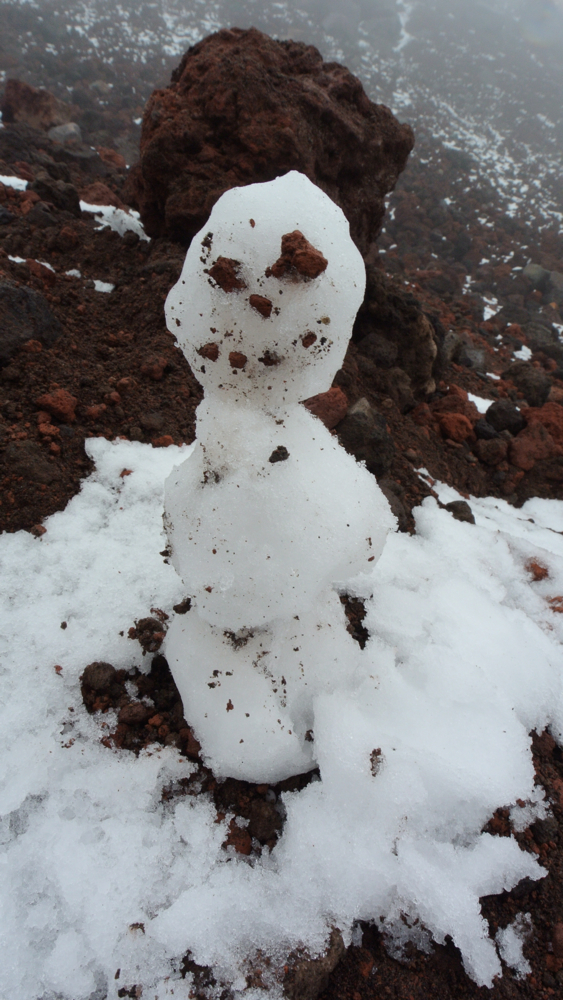
We trekked back down the steep hill to Truck, who was patiently waiting for us. Parked next to the truck was a collectivo who seemed to be having trouble. He had a flat tire and was attempting to fix it in the bitter cold, all on his own. We asked him if he needed help and told him we had an air pump. Together, Nate and the man pumped up the tire while I made lunch. Just before leaving, I placed a peanut butter and jelly sandwich with an orange on the tire for the man to snack on later. Sometimes, it’s the little things.
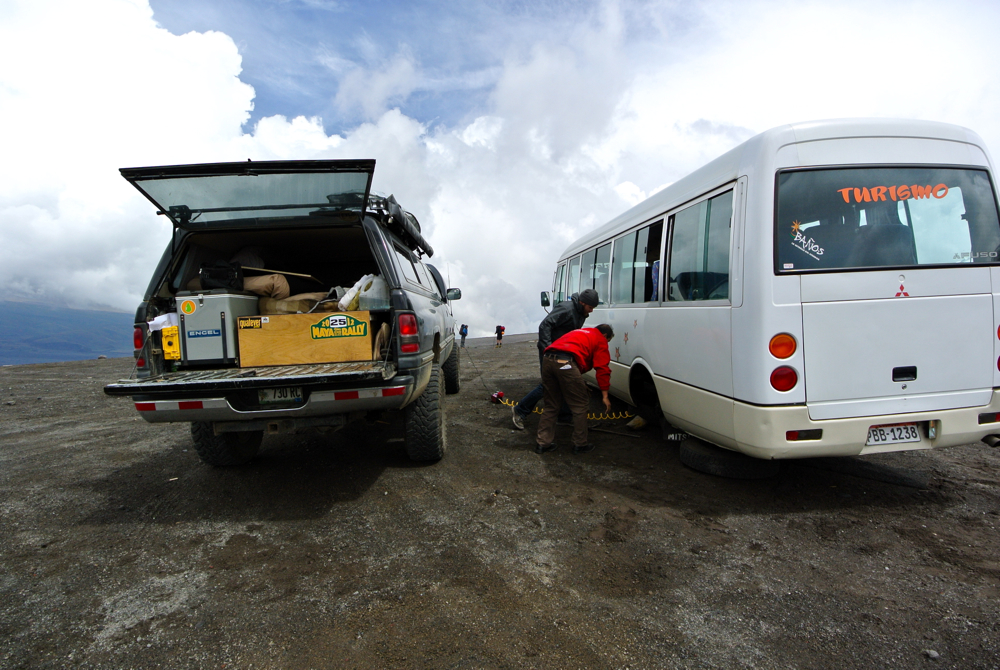
December 4, 2013 · by Sarah

Papers in hand, we were ready for our tenth border crossing. In a matter of fifteen minutes, all three of us were officially “checked out” of Colombia and on our way to Ecuador. Just as easily as we left Colombia, we entered Ecuador except for one minor hitch. After getting our passports stamped, we went to aduana (customs) where we were to obtain a vehicle import permit for the truck. Approaching the doorway, the man informed us of all the documents needed for the permit. We had everything we needed except for insurance for the vehicle. We had heard mixed reviews on whether you legally needed insurance in Ecuador, but with the official telling us it was necessary and it being printed on ‘the list’ hung all around the office, we were sent on a hunt to find it.
We were directed across the street where we could find a little tienda (shop) that would sell us insurance. We carefully crossed the street, while the police officer blew his whistle for us to hurry up, and approached the tienda. To our dismay, it was closed. We went to the shop next door and asked if she sold insurance. With a big head shake from side to side, she let us know that the shop next to her was closed (duh) and that we would have to go to Tulcan to buy it. Not wanting to drive the truck without insurance because of our previous misfortune in Colombia, we opted to grab a taxi.
After a twenty minute ride, we walked into the SOAT office. We explained what had just happened to the nice woman who shook her head and told us that she could not sell us insurance because we have a foreign vehicle and that we would have to go to Ibarra. Ibarra is the next biggest town…about three hours away. At this point we didn’t know what to do, so we just hopped into the taxi and went back to the border. Since we were officially checked into Ecuador and our truck was not, we didn’t have many choices.
To our surprise, the tienda was open when we got back! Excited, we skipped across the street and eagerly handed over our papers. For the next hour, we waited while the woman, wrapped in a fleece blanket, typed information into the computer. She would get distracted adding minutes to people’s phones for them, selling a trinket, or making change for people’s pesos, but would always go back to filling out our insurance form. At one point, she looked up, shaking her head back and forth, and said, “No, no hay.” There is none? What does that mean?? I could see the look across Nate’s face. It was similar to the look a child gives you after you give it candy and then take it away. Confused, frustrated, pissed. She told us she had the actual card, but she did not have any left in her computer. Stumped, we did the walk of shame back to the aduana official and told him what we had just done for the past two hours. Feeling sorry for us, he issued us an import permit anyway and told us to buy insurance right away in Ibarra.

Feeling lucky, but also nervous because we lacked insurance, we drove out of the border area on the nicely paved road. We were greeted by a gas station displaying a sign that read “Diesel $1.02” per gallon!!!! Although excited, we knew we couldn’t fill up Truck as the government has strict regulations banning the sale of more than ten gallons at a time within fifty miles of the border.

Ecuador has beautifully maintained roads and many are under construction as well. We were whizzing along the highway, eager to get to our first stop when we were forced to come to a halt. We had hit a section of road that was closed off due to repairs so we threw the truck in park and got comfortable. While waiting, a little old man was walking from car to car selling homemade popsicles out of his homemade cooler. We grabbed two and ate them while listening to music to pass the time.

We arrived in Otavalo mid-afternoon at our camp spot that overlooked the town and gave glorious views of the mountains surrounding us. We were still in awe at the different landscapes South America has to offer. That night, we made dinner to the view of the lit up town at the base of Volcan Cotocachi. The way the lights all came together gave the image that the volcano was on fire.

The next morning, we set off on foot to discover the town and find a shop to make us a new brake line. We only had one more that was showing signs of rot and wanted to take care of it before we had another incident like we did in Costa Rica or by the lake in Colombia. Thinking we were being smart by repairing it before it rotted all the way through, we found a shop, had one made and went back to the truck to take care of business. After about a half hour of Nate frigging with the brake line, he just couldn’t get the fittings to thread correctly. The man at the shop had given us metric fittings instead of standard. Although it was only the slightest bit of difference, it wouldn’t work. We went back to the shop, old standard fittings in hand, and asked the guy if he had any SAE fittings. He assured us the metric ones would work but we told him it didn’t. After a scavenger hunt to five other hardware stores, we couldn’t find the right fittings so decided to have him use the old ones.
In the middle of our galavanting around town for the new brake line, Nate and I decided to grab lunch at a cafeteria. Almuerzo (lunch) is considered the main meal of the day for Ecuadorians. Typically, it starts out with a piping hot bowl of soup followed by a heaping plate of rice, salad and chicken, beef or fish. We sat down and were immediately served a giant bowl of chicken soup. After we scarfed that, we were served beef with a mushroom cream sauce, rice and salad with a cup of juice. Each meal cost us only two dollars! Bellies full and huge grins strung across our faces, we waddled out of the restaurant to continue our walk back to camp.
Once back at the truck, Nate put the new line on. He was able to thread the fittings but the line wouldn’t stop leaking. We came to the conclusion that the flare wasn’t butting up to the housing correctly. We went back to the shop and asked the man to make a new flare for us because the other flare was crooked. After closely inspecting it, we were happy with the new flare job and went back to the truck. Nate, already covered in brake fluid, climbed back under the truck and attached the line again. After hours of tightening, loosening and re-tightening, it still wouldn’t stop leaking. I could see he was starting to regret our choice of taking it apart in the first place. Technically, nothing was wrong with the other one and now we had one that wouldn’t stop leaking. This time, I told Nate I would grab a taxi and make my way to town to get the flare fixed.

Taxi man at my side, we walked into the hardware store. Just as I was about to explain what I needed him to do, the taxi man grabbed the brake line out of my hand and took over. Once finished, the man handed the brake line back over to me. I inspected it as best I could but seeing as how I know nothing about mechanics and definitely don’t know how a flare should look, I asked him if it would be possible to rent his tool from him. This way, if the flare was wrong, Nate could fix it himself. The guy chuckled and said, “If you want to give me fifty dollars as a deposit then yes! heh heh heh” He was astonished when I slapped fifty bucks down on the counter, grabbed the tool and shoved it in my purse. I knew it was ballsy but didn’t want any more problems and knew Nate could fix it if he had the tool himself. The next morning, Nate borrowed Scott’s Dremel tool and, along with the flaring tool, got the brake to stop leaking. We have now decided not to touch anything unless it is already broken.
Otavalo is famous for its Saturday market, where indigenous people set up shop to sell everything from handicrafts to alpaca blankets to live animals. Of course, being the biggest market in Ecuador, we couldn’t miss out. We got dropped off at the animal market and made our way from there. The first animals we saw were live cows, chickens and pigs. Actually, we could hear the pigs squealing before we even saw them. We made our way over to where there were cats, puppies and guinea pigs being sold. People are very particular about which cuy (guinea pig) they are going to eat for dinner that night. Being a delicacy and all, I guess I would too.


We still have yet to eat guinea pig. I thought it would be a great opportunity to order one up in the cafeteria part of the market. We approached the first stand we saw and the woman informed us that they did in fact serve cuy. She asked me if I would like to see it first to make sure it was an okay size for our meal. I said sure and followed her over to the counter. She reached below the counter, picked up a bag and slapped it on the table. Inside the bag was a LIVE guinea pig. Squeaking and squirming around inside the bag, I felt bad for the little guy. As soon as I saw him, I knew I couldn’t do it. She told me it would take about an hour for it to be ready and asked me if that one was okay. As politely as I could, I told her that we might be back later for lunch. I think she knew we weren’t coming back.
When I was a kid, my sister and I had a guinea pig named Beethoven. I was always a little weird about playing with him outside of his cage, as he kind of freaked me out a bit. However, my sister, being the animal and rodent lover that she is, would play with him all the time. I kid you not about the rodent thing. A few years ago she fostered something like 12 rats at one time in her apartment… RATS! And she loved them too! Until his unfortunate death (even though she is an animal lover, being a kid is tough business and she may or may not have forgotten to feed the thing for, well, long enough that it died) he was a good pet and I am still having a hard time separating the fact that I had one as a pet and the fact that it is considered a part of the Ecuadorian diet.

After the animal market, we forced our way through the crowds to the town center where the rest of the market began. The market is so big that it pours into the adjoining streets and the whole town is shut down to traffic on Saturday mornings.

The dress of the locals in Otavalo is very unique. The women wear handmade, embroidered blouses along with either a folded head cloth on top of their head or an embroidered band of fabric wrapped around their ponytail. Their dress reminded us very much of the dress in Guatemala. The men have long hair braided down the center of their back, rope sandals and calf length pants. Some would be wearing a cowboy hat with the ponytail sticking out the back. Nate said they look like badasses and he would totally rock a ponytail with a cowboy hat if his hair would cooperate.

With the internet at your fingertips, it is easy to learn lots of new things. We made the mistake of teaching ourselves how to make pizza in our cast iron pan. We spent seven nights in Otavalo… three of them eating pizza :-/

The worst part? With the leftover dough, we started making cinnamon rolls for breakfast. Fat kids!!!!

One good thing Nate taught himself (or, I forced him to learn) was how to give me a proper haircut. Layers and all! He got really into a one point, flicking his wrist, saying, “I cannot work under these conditionssss!” with a diva-like attitude, lisp and all.

After about a week in Otavalo, we decided to pack up and head South to Cotopaxi National Park. About an hour into our drive, we stopped at the towering yellow post where the equator lies. We had officially made it to the middle of the world!!

The guide decided it was more important to fully check out our truck instead of giving us the typical tourist speech about the equator. We heard that they give you lots of interesting information about the equator’s history and even do some experiments, but our guide could only be found with his head under the hood of our truck.

Sitting at a whopping 19,347 feet, Volcan Cotopaxi is the tallest active volcano in the world. The park is home to many different landscapes as well. The beginning of the road is dotted with pine trees, planted there in a rehabilitation attempt to equalize the ecosystem. A few miles into the park, the landscape becomes a barren desert with one small, shallow lake on the western side.
We were lucky to get a few glorious glimpses of the volcano on our way to camp that night. The volcano beams high above, topped with an abundance of snow. The chilling view made us stop dead in our tracks, with our jaws hung wide open. This volcano is hardcore, raw and downright ************.

Pulling further into the park, we were engulfed in a think fog. We squinted our eyes to get a better glimpse of the road ahead. We followed the path until we got to our camp spot at the Tambopaxi Lodge. We quickly made our way to the lodge where we got a coffee and a tea and warmed up next to the fireplace.

The next morning, we made a delicious breakfast and sipped our coffee with a beautiful backdrop of the volcano. We are still amazed when we look out the window each morning and have something new to look at. Since we pulled into camp in such a heavy fog, we didn’t know what our surroundings looked like. I rubbed my eyes and pulled the curtain to the side. Like a kid on Christmas morning, I repetitively tapped Nate saying his name over and over until he woke up. Once he did, I said “Look! Look! You can see the volcano!!” And that you could. It was right there, filling up my window like a beautifully brushed painting.

After breakfast, we hit the road and drove up to the parking area where we could grab a trail and hike up to the snow line. Huffing and puffing, we were reminded of our hike in El Cocuy, Colombia where the lung collapsing altitude kicked our butts. This time, we started off about 15,000 and made it to 16,000 before it started snowing/sleeting. Officially the highest either of us have ever been in our lives, I celebrated by building a mini, dirty snowman.




We trekked back down the steep hill to Truck, who was patiently waiting for us. Parked next to the truck was a collectivo who seemed to be having trouble. He had a flat tire and was attempting to fix it in the bitter cold, all on his own. We asked him if he needed help and told him we had an air pump. Together, Nate and the man pumped up the tire while I made lunch. Just before leaving, I placed a peanut butter and jelly sandwich with an orange on the tire for the man to snack on later. Sometimes, it’s the little things.


